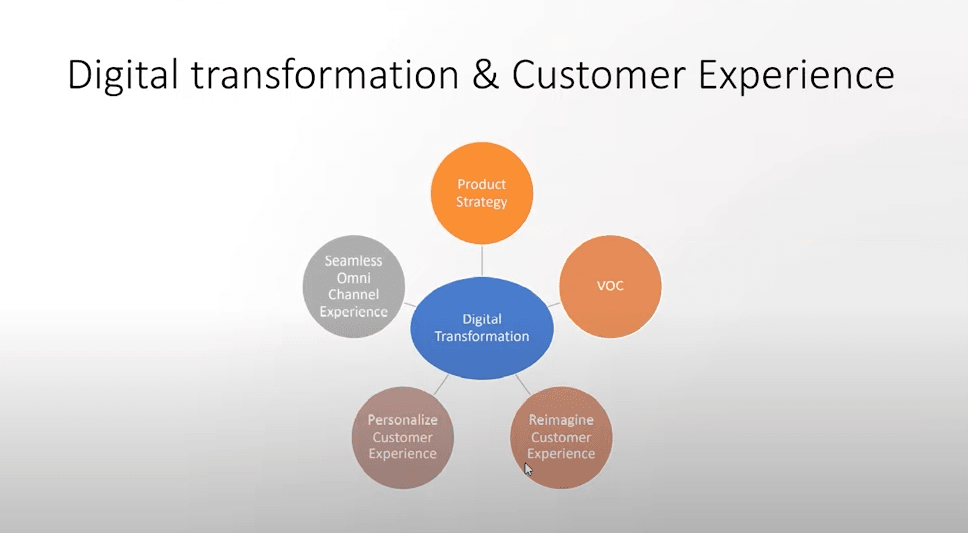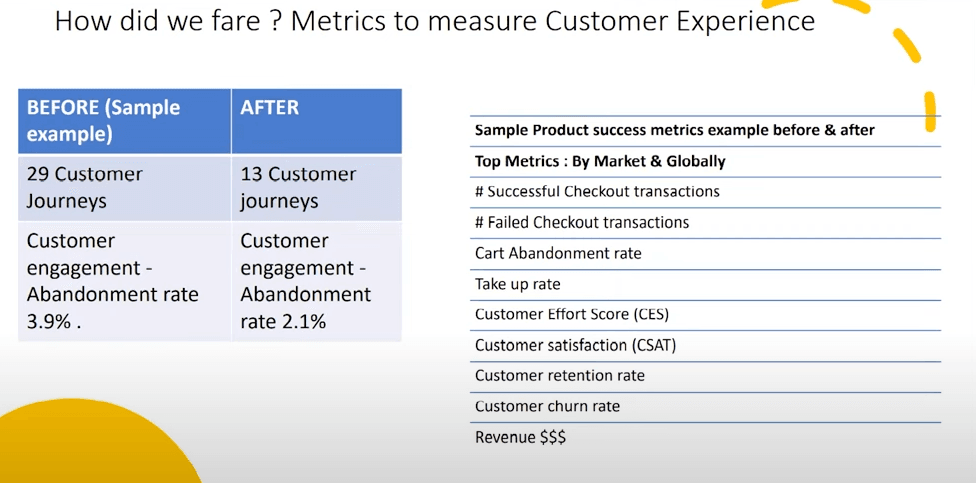Updated: April 25, 2024- 9 min read
With 5.3 billion active internet users, 5.6 billion unique mobile users, and 4.8 billion social media accounts, our world has become increasingly digital. With this in mind, digital transformation has never been more important, not just to remain competitive and increase revenue, but to enhance customer journeys and experiences. In this article, we’ll explore the role of customer experience in digital transformation, as well as how American Express managed to improve the customer experience in the eCommerce sector.
Editorial note: This post is based on the webinar Keep Digital Transformation Customer-Centric by American Express Sr PM, Niranjan Dravid, and contains additional insights and examples from the Product School team. You can watch the webinar in full below.
First up, let’s discover how digital transformation can enhance the customer experience.
Why is digital transformation necessary and how can it improve the customer experience?
It's a widely used buzzword, but at its core, digital transformation is about using technology to enhance business operations and increase revenue. It involves modernizing and improving technology to create better customer experiences, become more efficient, agile, and competitive in the marketplace. But it’s not just about improving business metrics.
As digital technology becomes increasingly widespread, it’s never been more important to harness its potential for the benefit of both businesses and customers. Here are some of the many ways it can improve the customer experience:
Enhanced customer data collection: Over time, customer data has become scattered across various platforms. To make this data meaningful and insightful, we need to collect it, establish data domains, and build relationships to effectively analyze and utilize this information.
Improved customer experience and customer-centricity: In the wake of the pandemic, the e-commerce sector has experienced astronomical growth. The global e-commerce market has surged from $4.2 trillion in 2020 to a projected $7.3 trillion by 2025. This substantial growth necessitates a focus on enhancing customer experiences and making sure that customer-centricity is at the forefront of our strategies.
Improved data-driven customer insights: This in turn can improve your decision-making processes. For instance, in American Express’s rewards ecosystem, we collect data on customer behaviors and patterns to target customers and segment them for specific promotions and offers. Behavior-based marketing is key here.
Increased customer engagement: During eCommerce journeys, keeping customers engaged positively can result in higher revenue generation.
Increasing revenue and achieving savings: However, it's essential to remember that it's not just about modernizing the technology stack. As product leaders, we must ensure that our customers remain at the center of everything we do, seizing these opportunities to enhance their experiences.
Custom team training
Learn how our training sessions can give your organization a competitive edge.
Digital transformation and customer experience
Digital transformation is compelling companies to adapt their business models to fit the evolving market reality. What's truly fascinating is that it's the customers themselves who are driving this change. I've had the privilege of being part of two significant digital transformation journeys. One of them was the largest in our company, completely revolutionizing the rewards experience for our customers, offering them a groundbreaking way to earn and redeem rewards. The second journey involved reimagining our eCommerce record for our digital payment product.
In such transformations, it's crucial to start with a clear product strategy. This strategy should outline where we are today, where we aim to be in the future, and the steps we'll take to get there. Having this strategy in place is paramount for improving customer experiences.
Next, it’s essential to consider the Voice of the Customer (VoC). Evaluating existing customer journeys on the platform begins by gathering feedback from customers. Engaging with customers for their input and, more importantly, understanding their pain points within these journeys is vital. Feedback can be sourced from various channels, including customer care, surveys, social media platforms like Twitter, and even through A/B testing. These insights help in enhancing user interfaces and user experiences (UI/UX).
Lastly, it's about reimagining the customer experience. Once we've gathered insights and feedback, we can begin to design improved, consistent, global, and frictionless customer journeys. Ongoing feedback from customers helps us measure the success of these transformations. It's worth noting that, according to a survey, 40% of customers identified customer experience as their top priority in the realm of digital transformation.

The importance of empathy in customer experience
After gathering feedback from our customers, empathy mapping or customer experience mapping becomes a critical tool. This ensures that your team is entirely focused on the customer in the way they carry out their responsibilities. Every aspect of your digital property's design and functionality should stem from a robust understanding of your target customers. However, to reach that level of customer knowledge, you must rely on the customer data collected from Voice of Customer (VoC) feedback.
Empathy is a crucial attribute in the realm of customer experience design. Without empathy, you won't be able to put yourself in the shoes of your target audience. You won't be able to see what they see, feel what they feel, and process experiences the way they do. When empathy is at the center of your approach, it brings several benefits. Firstly, it deepens your understanding of the customer, eliminating guesswork not only in the product you're creating but also in how you create it.
After reimagining the customer experience, it's vital to personalize those experiences based on historical customer data. Implementing machine learning algorithms can help you understand customer trends and clusters. For instance, we used unsupervised algorithms to identify clusters of customers with specific preferences or behaviors. For example, if a customer frequently redeems rewards on Amazon, it's worthwhile to provide them with personalized reward redemption offers.
You can then extend these personalized experiences to seamless omni-channel experiences, whether on desktop, mobile web, or mobile app, to ensure a consistent and transparent customer journey.
Learn How to Leverage Machine Learning in eCommerce
eCommerce businesses must prioritize machine learning if they don’t want to be left behind in a sink-or-swim sector. Discover how to leverage the power of machine learning with five practical use cases and real-world examples from industry leaders in this Product School blog post.
Read Now
Case study: How American Express improved customer experience with digital transformation
One of American Express’s payment products is designed to support the eCommerce checkout authentication journey with value-added features. We noticed a significant issue in one market where customers were abandoning their carts due to friction in the authentication process. Data collection revealed that additional authentication steps, coupled with value-added features, were causing this friction and, consequently, card abandonments, resulting in revenue loss.
Every card abandonment represents a missed revenue opportunity, as customers' attention spans in eCommerce transactions are typically short — around 30 to 45 seconds. To address this, American Express focused on improving the customer journey.
Initially, the abandonment rate was as high as 3.9%. To reduce this, we reimagined the customer experience by redesigning the user interface (UI) and user experience (UX), making the checkout journey smoother. We also collected customer preferences upfront for certain value-added features that sped up the process. As a result, we improved revenue figures by reducing abandonment rates to approximately 2.1%. This helped recover previously lost revenue, and we continue to work on further reducing abandonment rates.
Digital transformation and customer-centricity
American Express, as you may know, is not just a credit card company; it has diversified lines of business, including digital banking for both business and consumer customers, personal loans, and cross-border payments.
Let me highlight an example of customer-centricity in our approach. When we reimagined our global rewards experience, our vision was to consolidate all customer relationships, regardless of the payment instrument used (card or non-card), and provide a unified rewards experience. This approach was transformational, impactful, and revolutionary.
We aimed to offer customers a single view of their rewards, maintaining transparency in payment instruments and engaging closely with them to show their reward balances, how they earn those balances, and more. Keeping the customer at the center of everything we do is crucial to providing a differentiated and improved customer experience throughout the digital transformation process.
Product metrics to measure the success of digital transformation
One sample metric shown here compares the situation before and after the transformation at American Express. As you can see in the graphic below, we previously had 29 customer journeys and now have 13, but that doesn't automatically guarantee an improvement in customer experience. So it's essential to consider additional metrics to evaluate success.

On the right side of the graphic, you can see some sample metrics that should be collected before and after a digital transformation. These include:
1. Number of successful checkout transactions.
2. Number of failed checkout transactions.
3. Card abandonment rate.
4. Take-up rate (indicating whether customers accepted the value-added features offered during checkout).
5. Customer Effort Score (CES), which measures how much effort customers need to complete a journey.
6. Customer Satisfaction Index (CSAT), assessing how happy or unhappy customers are with your product.
7. Customer retention rate.
8. Customer churn rate.
9. Active transactions (measuring the level of customer engagement).
10. Revenue impact (the most critical metric, indicating whether revenue has improved due to enhanced customer journeys).
Discover the Product KPIs & Metrics That Every Product Manager Should Know
In the data-driven world of product management, metrics and Product KPIs are vital. Discover the key metrics and KPIs that every product manager should know and use.
Read Now
Key takeaways to improve the customer experience
Now that we’ve investigated the role of customer experience in digital transformation, let’s round everything up with these key takeaways to lead digital transformation to improve the customer experience:
1. Customer Empathy: Take the time to truly listen to customers and put yourself in their shoes. Understand their pain points and joys. Imagine what it would be like if you were using the product every day.
2. Advocate for Customers: Be an advocate for the customer, taking their feedback seriously and championing their interests within your organization.
3. Reimagine the Experience: Don't focus solely on reimagining platforms; also consider how the customer experience can be reimagined and improved.
4. Ask "Why?": As a product manager, maintain curiosity by consistently asking "why?" and seek to understand the underlying reasons behind decisions and actions.
5. Clarify the "What" and "Why": When communicating with stakeholders, provide clarity not only on what needs to be done but also on the reasons and motivations behind those actions, especially for engineering teams.
6. Behavior-Driven Design: Encourage and champion behavior-driven design and use clear and concise use cases for acceptance criteria.
7. Data-Driven Decisions: Leverage data to inform and guide product decisions. Historical data is invaluable for understanding trends and making informed choices.
8. Trust and Verify: Finally, maintain trust in your processes and decisions but also verify and validate them to ensure they align with your objectives and customer needs.
Updated: April 25, 2024




